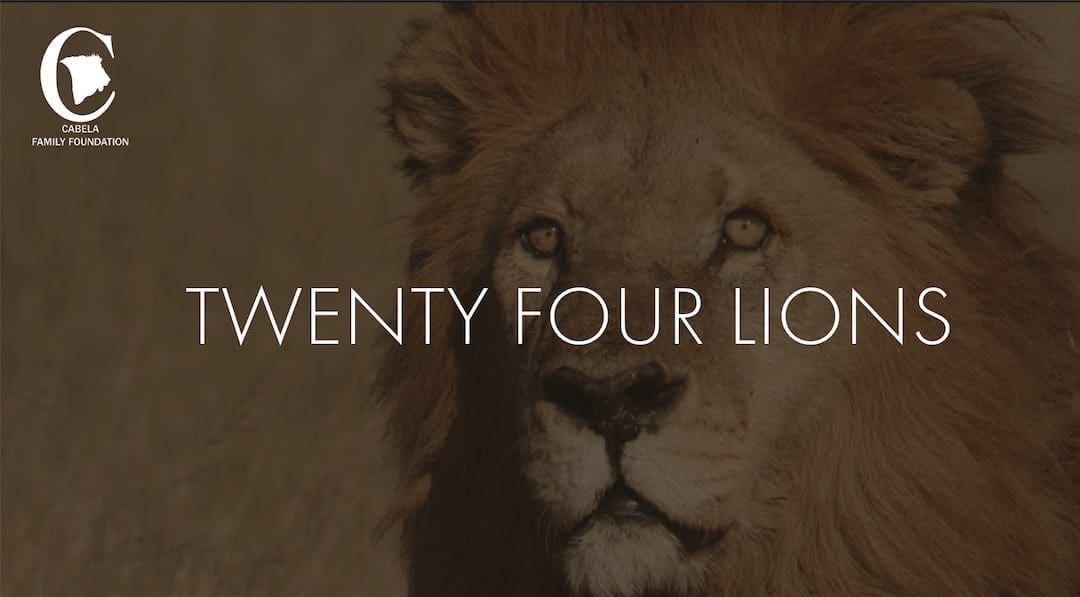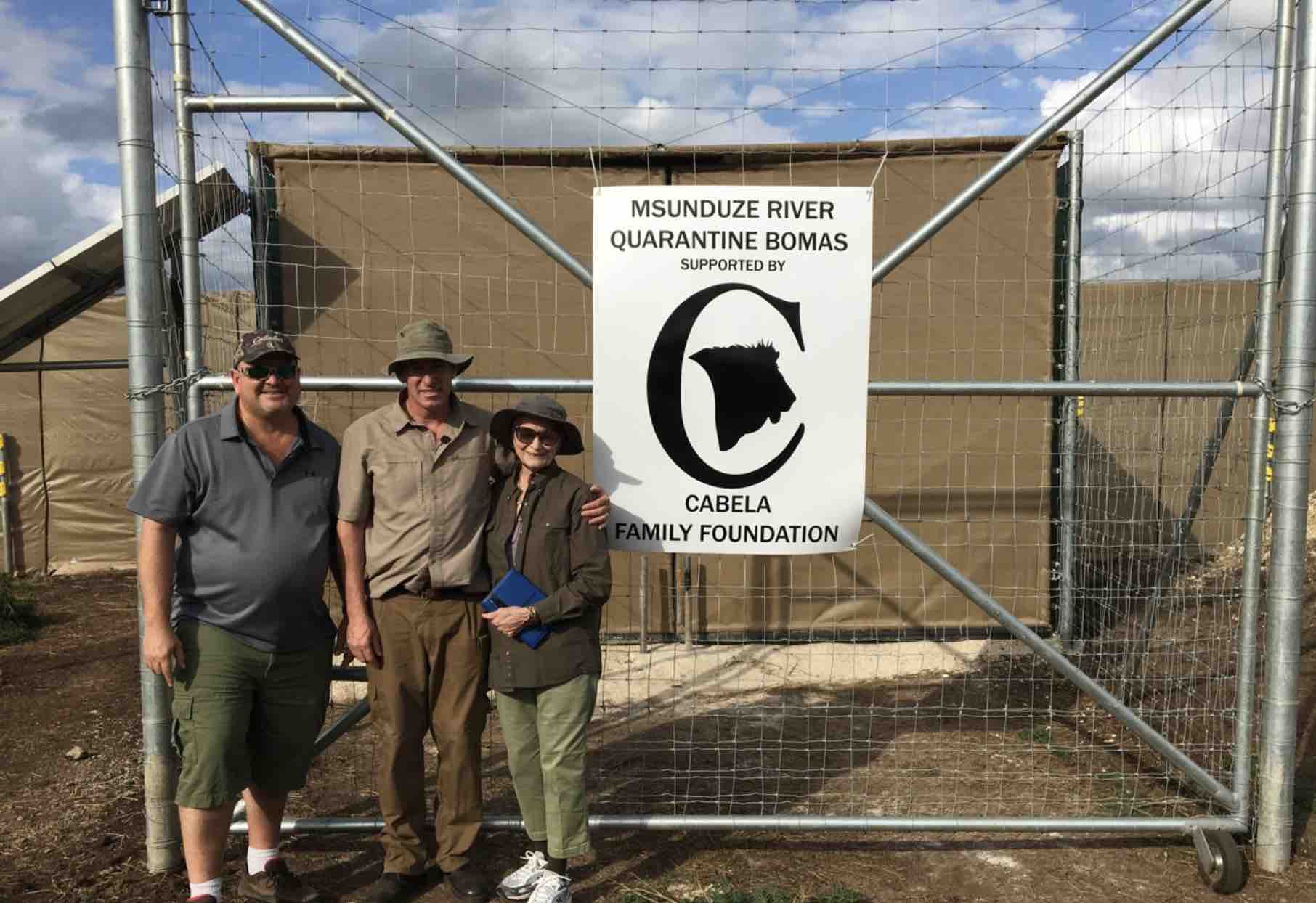Dan Cabela talks 24 Lions, Hunting and Conservation

We are absolutely honored to be able to interview Dan Cabela about the 24 lions conservation project in Africa.
Can you tell us about the Cabela Foundation and the work you are doing in Africa?
The Cabela Family Foundation works to promote outdoor recreation, conservation and charity toward others. We focus to become involved and supportive of projects the reflect the ideals and value systems of our parents and our family. We are currently involved in two larger projects as well as financially supporting several other organizations and projects. 1) The Dick and Mary Cabela Sustainable use area at Cimmaroncita. This project is located at the Boy Scouts of America Philmont Scout Ranch and will serve as an area for conservation and outdoor recreation training area. It is a 2,700 acre area where future sportsmen can learn fundamental outdoor recreation and wildlife conservation skills. We see this project as a vital long term investment to connect future sportsmen and women to wildlife conservation and outdoor recreation. 2) As for work the foundation is doing in Africa, 24 lions is the most ambitious conservation initiative we have been involved in to date. African wildlife and culture holds incredible meaning to our foundation founders and current board members. The human-wildlife conflict in most African wild spaces has resulted in declining wildlife numbers. Particularly lions. Ivan Carter brought us a meaningful and lasting opportunity with a high potential for success to restore lions to the Zambezi Delta. Although there are certainly risks involved with this kind of relocation, we felt the potential benefits to lion conservation greatly outweighed the risks.

Dan Cabela, Ivan Carter and Mary Cabela at the Quarantine Bomas
We have recently been reading about the work of reintroducing lions Mozambique’s Zambeze Delta, can you tell us about the 24 lions project?
As stated above, Ivan Carter brought our attention to this idea. We planned for 2 years with numerous setbacks but our partners stayed true to the cause and were never disheartened. Prior to Mozambique’s civil war, all wildlife (including lions) thrived in this roughly 2 million acre delta area. While other species have recently returned to expanding populations and flourished, the African Lion never recolonized the area. Because of this the ecosystem is out of balance. An apex predator used to exist here and should now. We decided to start with a seed population of 24 lions (18 female, 6 male) We chose genetically diverse, free ranging, wild lions that are the same sub-species found in other areas of Mozambique. This is, in fact, the largest lion move to date across international boundaries.
Can you tell us a bit about the process of moving 24 lions from South Africa to Mozambique’s Zambezi Delta?
Lions were captured and put into bomas (large holding areas) in South Africa. Groups were socialized during quarantine period to form larger social units to promote greater hunting success once released in the wild. We employed two veterinarians and a Doctor of Zoology to make sure our we followed all the proper planning and protocol to ensure success. After the lions were tested and proclaimed in excellent health in accordance with international law, they were inspected and certified by wildlife authorities and export/import permits were issued. The lions were then transported by aircraft to Mozambique. 15 collars were placed on the lions for close monitoring upon release. Collars were also placed on Buffalo, Sable, Zebra, reedbuck and warthog so we could gather data and measure behavioral changes in other species with the introduction of the lions. The local community was widely consulted about the arrival of the lions. Concerns and suggestions were taken into consideration and implemented where possible. The local community welcomed the lions. To date, the lions have done very well and I do not think it will be long before cubs are on the ground.

Mary Cabela with three of the lionesses
We have long been hearing about the good work that Mark Haldane has been doing with Zambezi Delta Safaris. Can you tell us a little bit about the anti-poaching work that they are doing?
Mark Haldane has made a 24 year investment in Coutada 11 and the ecosystem has made an incredible recovery during his tenure. His anti-poaching program (funded by hunters) uses helicopters, motorcycles and foot patrols. He has formed partnerships with the local community and built schools, a medical center and provided meat drops (30 tons in 2017) from game hunted to keep local subsistence poaching to a minimum. Anti-poaching staff has been hired from local community. A bed tax paid by each hunter is given directly to the community. All of these things have been funded by hunters. Poaching is at an all-time low and wildlife numbers are the highest seen in decades. This is certainly one of the best wildlife comebacks in an unfenced area in recent history.
We recently saw the report of lion 2783 that got his leg trapped in a gin trap and he had to be euthanized after breaking his leg. It must be heartbreaking to be a part of these stories. How are the rest of the lions doing in that area?
Some of this was highlighted above, but I will expand a little bit focusing primarily on the delta as this is what we are talking about. These conservation principles would be effective anywhere on the continent. As stated above, hunters pay for the anti-poaching, humanitarian and educational programs in the area. This benefits the wildlife and the people. Giving the wildlife true value to the local community provides protection to the wildlife. All stakeholders working together for the good of the ecosystem and now the lions. Below are a couple of statistics that may help my assertions. Keep in mind that this is a hunting concession and these numbers are a direct result of hunting used as the primary conservation tool. The Mozambique wildlife department has conducted independent wildlife surveys since 1994. 1994 1,000 buffalo/today 20,000 1994 44 sable/today 3,000 Lion 2783 was a set back but not unexpected and this scenarior was certainly talked about prior to initiation. We thought we would have some males that would wander. However, It did happen sooner that expected. One good thing that came out of this was the government came down hard on the poacher. Much more serious that normal. We have involved the government in this project from the beginning and they are a critical partner. The publicity generated by this unfortunate situation, caused a swift and harsh reaction. Hopefully, this will help to discourage this sort of thing in the future. All of the other lions are doing quite well and the plan seems to be moving along nicely.
Canyou tell us about the Go Fund Me campaign for Twenty Four Lions and how people can make a difference in funding this campaign?
We started the go fund me campaign to help with some unforeseen additionalcosts that were not considered in our original budgeting. Use of helicopters toput human eyes on lions in something that needs additional funding. We try tosee the lions from the sky at least three times a week. Originally, we thought moreof this could be done by vehicle, it hasn’t worked out that way. Our male lionthat was caught in the snare would have suffered far longer without us locatinghim quickly from the sky.
Why did the 24 Lions Project partner with a hunting operator who may only be doing it to hunt the lions in the future? Why not do this in a photo safari area or a national park where the lions will never be hunted and thus protected?
We chose this particular hunting bloc because Mark has an incredible long term record of using the hunting model as the primary tool for Wildlife Conservation. If you look at the expanding wildlife numbers in his area, this model has been very successful. This area is also appealing because it is a large, intact wild ecosystem. It is our thought that the remaining wild spaces of the world need to be protected. Through wildlife conservation, we have a better chance at preserving these places. I certainly see a great benefit to photo safaris and national parks, but if we reduce all wildlife conservation initiatives to these areas, we end up with a very small footprint for the wild animals of Africa. Through our agreement, these original 24 lions will never be hunted.
How long will the Cabela Foundation need to continue funding the follow-up and upkeep for this project, and where will that funding come from? At what point would you consider the project a success that no longer requires funding to maintain it?
We have a six year commitment. Much of the operational funding will come from the Cabela Family Foundation, but there are opportunities for outside funding and we hope to gain some partners. Although we already consider the project a success, a couple generations of new lions down the road would validate our efforts.
What message or understanding would you like the general public to learn from the 24 Lions Project and the Cabela Foundation’s work in conservation?
The wild lion population is declining in Africa. This project has the long term potential to increase the wild lion population by 10% over the next 15 years for the entire continent. Hunters have always had the deepest connection to wildlife. Hunters have always worked to protect wildlife. It would be devastating to wildlife if the hunting community was not involved in wildlife conservation. There are many examples of this currently in African countries where hunting has been closed. No hunting equals no regulations, no enforcement, no incentive, no value, no protection. Not a pretty picture for wildlife. We believe it is critical to educate people on the important work and role that hunters provide to wildlife conservation.

The blog you have shared was quite interesting. You have shared the great advice to move 24 lions from South Africa to Mozambique’s Zambezi Delta. Thank you for sharing this blog.